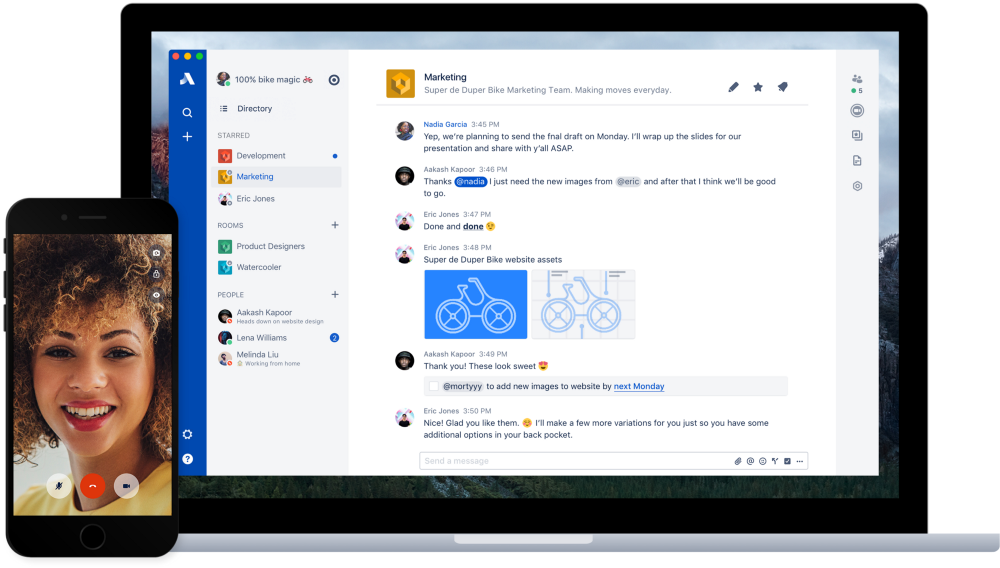 APPS
APPS
 APPS
APPS
 APPS
APPS
Six months ago, software development and collaboration tool maker Atlassian Corp. Plc launched its team communication tool, Stride, into early access. Since then, the tool has been adopted by tens of thousands of teams who put it through its paces and to a lot of use.
To celebrate, Atlassian published its findings from the past six months. Stride ties together numerous multimedia forms of communication into one interface by incorporating threaded conversation text chat, voice and video meetings and other team collaboration tools such as screen sharing and storyboarding all in one place.
“With Stride Meetings, I can get face to face with anyone on Earth — whether they are in my company or not,” said Taylor Facen, product manager at Freeman Capital. “I can share a simple link or dial them in directly. It’s an incredibly powerful tool.”
In the past six months, the Atlassian Stride team has also added more than 50 new features and improvements based on customer feedback. For example, Stride now allows users to better organize conversations with customizable ordering for chat lists such as alphabetical sorting and starring. Search functionality has also been improved to find things faster and with smarter functionality. And the Meetings feature has been streamlined to allow quicker connections for face-to-face video with teammates, allowing for seamless shifting from text chat to video meetings with fewer button presses.
“We built Stride with the belief that your messaging app should maximize collaboration and minimize distraction,” an Atlassian spokesperson wrote on Stride’s blog. “But we also know that sometimes getting work done requires stepping away from it all.”
To implement this sort of “work first” mentality, Stride added a feature called Focus Mode. With Focus Mode enabled, all notifications and incoming messages are muted or deferred and a message is sent to contacts that the user is in the midst of a deep dive.
According to Atlassian, early users have already spent more than a quarter of a million hours with Focus Mode active.
“Stride’s Focus Mode feature has been a lifesaver for developer productivity,” said Steve Gallion, chief executive of MedTrainer. His company made the switch from the free version of Slack to Stride Standard because his teams found higher value in it than other free products. “And every member of our DevOps teams use Focus Mode to ship their code uninterrupted.”
Although the paradigms surrounding agile and DevOps styles of development require a great deal of communication – and sometimes an always-on sense of urgency about approaching features – inevitably all of that interconnectivity must lead to an end product. That means that all those meetings eventually turn into a closed office door, with a developer under headphones, crunching away at code to get the work done.
Atlassian’s own focus on the needs of development and management teams also flows into how Stride connects with other products. To make sure that teams can hook up with Jira Software, Bitbucket and Trello, to name a few integrations.
This means that people using Stride have button-press-ready mechanisms that bring them directly into the platform that they need. This is a user experience and cultural expectation that Atlassian has been building into its products for a long time: the reduction of what Hamid Palo, director of partnerships at Trello, calls “context switching.”
When Atlassian integrated Trello into most of its products, the company did so by providing a way for users to access Trello without ever exiting the app (in this case context) they were operating in.
“In Slack, developers had to jump between platforms all the time,” Gallion said. “Stride’s integration with Jira Software in particular is rich and actionable from within the chat room.”
Stride can also do this with third-party apps and also connects with Dropbox and Google Drive for external storage solutions. This is part of what Atlassian calls its app ecosystem, a suite of 20 different apps that operate with Stride, many of which are commonly used and therefore most teams are already familiar.
Some examples of apps that can be found in the Stride app marketplace include Outlook Calendar, GitHub, Salesforce and PagerDuty – and, for people who want pretty moving images, there’s also Giphy.
Now that this first six months of Stride is out of the way, Atlassian will be providing a way for HipChat Cloud teams to upgrade to Stride. Hipchat is Atlassian’s text, screensharing and video conferencing software and Atlassian has said it expects to see HipChat users migrate to Stride over time. Over the next few months, teams will be migrated and details are available for managers to know what they need to get ready.
THANK YOU